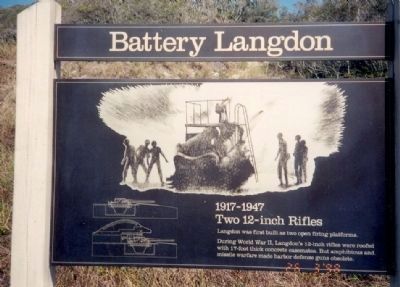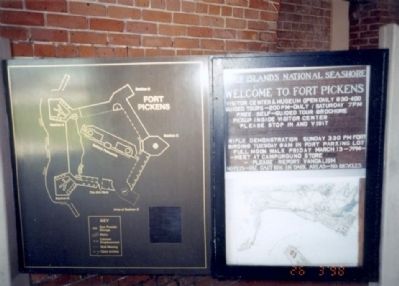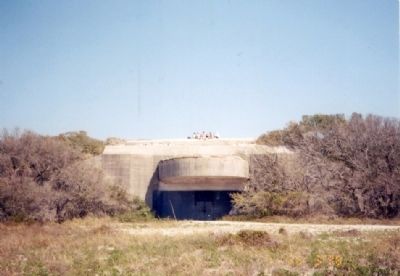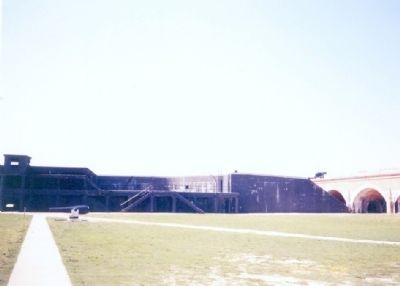Pensacola in Escambia County, Florida — The American South (South Atlantic)
Battery Langdon
1917-1947
— Fort Pickens —
Langdon was first built as two open firing platforms. During World War II, Langdon’s 12-inch rifles were roofed with 17-foot thick concrete casemates. But amphibious and missile warfare made harbor defense guns obsolete.
Erected by Gulf Islands National Seashore, National Park Service.
Topics. This memorial is listed in these topic lists: Military • War, World I • War, World II.
Location. Marker has been reported missing. It was located near 30° 19.62′ N, 87° 17.652′ W. Marker was in Pensacola, Florida, in Escambia County. Memorial was on Fort Pickens Road. Touch for map. Marker was in this post office area: Gulf Breeze FL 32561, United States of America. Touch for directions.
Other nearby markers. At least 8 other markers are within walking distance of this location. Battery Cullum, Battery Sevier (within shouting distance of this marker); Battery Van Swearingen (about 400 feet away, measured in a direct line); Battery Payne (about 600 feet away); Colonial Power Struggle (approx. 0.2 miles away); Massive Smoothbore (approx. 0.2 miles away); Hurricane Ivan (approx. 0.2 miles away); Apache Prisoners (approx. 0.2 miles away); Fort within a Fort (approx. 0.2 miles away).
Regarding Battery Langdon. Gulf Islands National Seashore FL, MS
Fort Pickens
Fort Pickens is the largest of four forts built to defend Pensacola Bay, Florida, and its navy yard. The fort was begun in 1829, completed in 1834, and was named in honor of Major General Andrew Pickens of the South Carolina militia, who fought with distinction in several Revolutionary War battles including Cowpens and the Siege of Ninety-six. He also led several campaigns against the Cherokees, who called him "Wizard Owl."
Fort Pickens was one of only four forts in the South that was never occupied by Confederate forces during the Civil War, thanks to a heroic stand by Lieutenant Adam Slemmer with one company of artillery and a few sailors, aided by one U.S. Navy ship, the Wyandotte. Fort Pickens was as important as Fort Sumter in Charleston, S.C. during the crisis between Abraham Lincoln's election in November, 1860 and the firing on Fort Sumter on April 12. 1861. The fort was reinforced the day after Fort Sumter surrendered, preventing the Confederates from controlling Pensacola Bay and using the Pensacola Navy Yard.
Confederate troops under General Braxton Bragg crossed the bay and made a night attack on the camp of the 6th N.Y. Infantry Regiment about a mile east of the fort on October 9, 1861 in the Battle of Santa Rosa Island, involving around 1800 men and resulting in about 150 casualties. In retaliation for that attack, Federal artillery from Fort Pickens, along with the USS Richmond and USS Niagara, bombarded Confederate positions at Forts Barrancas and McRee, the navy yard, and several independent batteries spread along the bay shore on November 22 and 23, 1861. Almost 5000 shot and shell were fired at Confederate positions, causing heavy damage to both Fort McRee and the navy yard, and leading to Confederate withdrawal from Pensacola Bay in May of 1862.
Built in the age of wooden warships and cannons firing round balls, the fort underwent changes in response to advances in weapon technology following the Civil War. Armored warships (like the "ironclads" Monitor and Merrimac) with steam engines and screw propellers, as well as larger and more powerful rifled cannons, made brick and stone forts obsolete.
Ten concrete gun batteries, including one in the middle of the historic fort, were built from the 1890s through the 1940s, each a response to a particular threat. Atomic bombs, guided missiles, and long-range bombers made such forts obsolete by the end of World War II and the Army abandoned the forts. The fort became part of a popular Florida State Park until the creation of Gulf Islands National Seashore in 1971. Following extensive repairs by the National Park Service, the fort was reopened in 1976.
Additional commentary.
1. Sign replaced
It appears that this marker has been replaced by a newer one along with all the markers at Fort Pickens. See newer marker.
— Submitted January 2, 2015, by Mark Hilton of Montgomery, Alabama.
Credits. This page was last revised on June 20, 2018. It was originally submitted on December 18, 2012, by Don Morfe of Baltimore, Maryland. This page has been viewed 951 times since then and 51 times this year. Photos: 1, 2, 3, 4, 5. submitted on December 18, 2012, by Don Morfe of Baltimore, Maryland. • Craig Swain was the editor who published this page.




